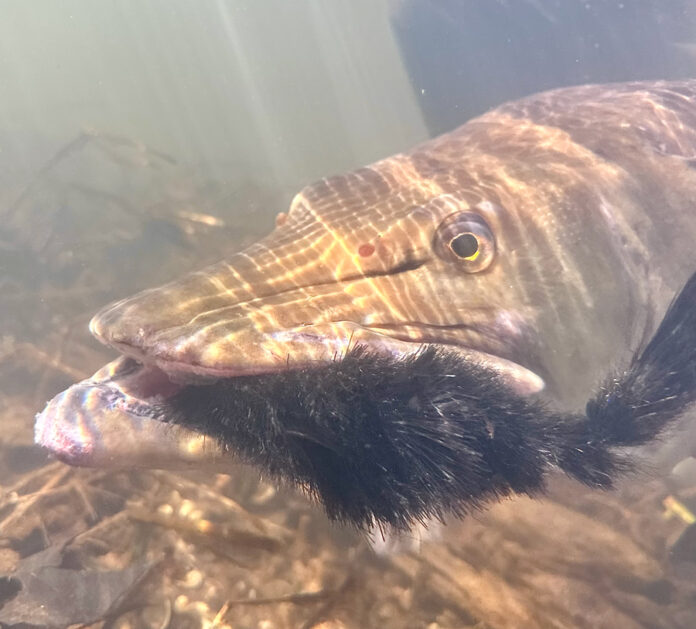Written by: Drew Price
Photo by Blane Chocklett
Muskellunge are the fish of legends—top-tier predators that are notoriously challenging to catch on even conventional tackle. Back in the mid ’90s, when I first started chasing muskies with a fly, people thought I was nuts. Now, these toothy monsters are part of fly-fishing culture.
Twenty-five years ago, there was almost nothing written about how to catch a musky on the fly. I would occasionally see Larry Dahlberg chucking flies at muskies on “The Hunt for Big Fish” tv show, but there was almost nothing else. Because there were no specialized flies or other gear for muskies, I started off with 8- and 9-weight rods, built my own leaders out of heavy monofilament, and used single-strand wire for the bite guard. I didn’t have a boat, finding access on foot was a big part of the game. I spent a lot of time casting the biggest Deceiver-style flies I could twist up, in water I could wade in—and it very rarely paid off.
Highs and Lows
I’ll never forget that first successful day. The weather was downright nasty in July. A thunderstorm was rolling in, and I probably should not have been standing mid-thigh in a river with a lightning rod in my hand; but I was obsessed. The fish were on the feed, and I managed to get two on the same day. Both measured in the upper 20s—not even “legal sized,” which was 30 inches at the time, but they were muskies. And I had finally broken the code . . . a little bit.
Next, I got a canoe and upgraded my gear as best I could. A new 10-weight made it easier to throw big flies and gave me more leverage during a fight. The old saltwater hooks that you had to file sharp before tying on them were replaced with hooks that started sharp and were designed for predators. New fly lines designed for bigger flies and new wire bite tippet came on the market. Different flies ended up in the box. My catch rates increased, bigger fish came to hand, and I even got a musky tattoo. I spent most of the summer chasing them, mostly floating by myself, looking for fish, and learning all I could. I rarely saw another angler.

Photo courtesy Drew Price
Over the next decade, muskies got popular—really popular. Spots I had kept quiet for years were suddenly being discussed on the Internet. Lots of anglers showed up in places I hadn’t seen any before, and I became disheartened. I only hunted muskies on occasion, but I paid attention to all the changes going on in the sport, as well as the anglers driving that change. One name that became prominent was Blane Chocklett, who was having incredible success with big muskies on new, articulated flies.
Fast forward to 2021. I had been guiding for quite a while on Vermont’s Lake Champlain and had become well known for chasing bowfin. The MeatEater video series “Das Boat” was looking for a guide for bowfin in Vermont, and they got in touch. The two guys in my boat ended up being Oliver Nye and Blane Chocklett. Blane and I connected over our mutual love for the toothy, prehistoric bulldogs we were chasing. We got to know each other, and he saw what a diverse and amazing fishery that Lake Champlain has to offer. We kept in touch, and when he said he had some openings for muskies this winter, I immediately booked him.
In Search of a Giant
I headed to Virginia with all the right gear: three 11-weight rods and a 10; heavy fluorocarbon and bite wire; new sinking fly lines; and all the cold-weather gear I should need for January fishing. I was so excited that I could barely sleep the night before. I tend to be a bit excited at the best of times, and an opportunity like this just spools me up.
The weather was looking wonderful: mid 50s, a far cry from what I would normally be dealing with in Vermont in January. Blane picked me up, and we went out for breakfast to let the air and water warm up a bit. Over an omelet, he explained to me that we would have to play a bit of chess to find the right piece of water. Because of Blane and a few other guides’ success with large muskies in Virginia, there’s now a fair amount of competition. Success is a double edged sword, often leading to more people using the same water for the same purpose.

Photo by Blane Chocklett
We drove around to find water that wasn’t being pressured, and we took our time. As we geared up to launch, I put together my Clearwater 11-weight set up, and Blane explained his rigging recommendations. We talked knots and leader building, and he explained why he prefers the Scientific Anglers Predator Nickel Titanium Wire for the bite tippet. For a fly, he suggested a black MegaChanger. There was no sense of hurry.
The Adipose drift boat slipped through a riffle to the head of a huge pool. Blane dropped the anchor and had me make a few practice casts. I was struggling, as I hadn’t cast a big rig like that. Although I have been fishing musky more the past couple of years, I have been using T-bones and other lighter patterns. The line I was using wasn’t up to the job, either, so Blane loaned me an SA Sonar Musky line, which worked a lot better.
I was working on dialing in my cast and retrieve, which weren’t easy with a fly the size of a baby squirrel. The Game Changer platform is remarkable in how lifelike the flies move, and the 11-inch monstrosities Chocklett uses for muskies take it to a new level. There is no question how effective those flies are, and it is because of the work that Blane has done to decipher what triggers fish to strike.
The fish were holding deep in the 38-degree water, and Blane explained that the grab would be pretty gentle. The fish hit the fly and keep moving through the water, taking the fly with them. It feels like you are caught on leaves. To set the hook, you just keep stripping line.
Connection

Photo by Blane Chocklette
Blane explained that the head of the pool is where these fish come to feed, holding in a specific pocket. While I was practicing, I didn’t notice that we had dropped down a bit right into the zone. Blane had decided I was ready. I made a cast into the pocket he was talking about, fed out line to get it down, and started stripping. Suddenly, there it was–leaves on the fly. I kept stripping until I felt weight and the rod doubled. A golden olive shape emerged from the depths. “It’s a giant!” I was stunned.
The fish came up and shook its massive head a couple of times, slashing those immense jaws through the water. I led her to the huge net that Blane had ready, and she slid in. I can’t even begin to describe the feelings that went through me at that moment. I was stunned, stupefied, overwhelmed, emotional. I had come on this trip with the dream of breaking the 50-inch mark, which I had yet to do. Over the last 30 years, I had had encounters with massive fish that had left me flustered and I had even hooked and lost huge muskies.
Now I was holding the net with not only a big fish, but truly a top-end specimen. As we drifted down I looked back at Blane’s smile. He looked at me and said “I know man. I know. A lot of people cry.” I am not ashamed to say that I wept.
We anchored on a shallow bar. Blane knew this fish, as he guided someone to it a couple of years ago. Studies have shown that a fish of 48 inches is about 18 years old. Muskies over 50 inches grow slowly, typically gaining more girth than length. A fish of this size is also an egg-producing machine. Considering that roughly a third of all eggs a musky lays will be infertile and that a very small percentage of the fish that do hatch make it to spawning age, careful handling of giant fish is a critical tool for conservation of these apex predators.
We took pictures to document the catch. There were a few comedic moments, as I managed to get my rod and line tangled in a branch a couple of times. We never lifted her entirely out of the water. The love and respect of these fish is apparent in how Blane handles them. Holding her in my hands and looking down at her, I was filled with awe, and frankly I still am. The distance between her eyes was easily five inches. This was a top end predator, and I felt blessed to have this encounter.

Photo by Drew Price
The fight had lasted all of a minute. Hard to believe, but with cold water, strong tippet, a heavy rod, and a skilled guide, it’s possible. It didn’t take much for her to revive, and we watched her swim off strongly.
We got back in the boat, I sat, still looking stunned. Blane looked at me and said, “That was a very special fish. I would like to honor and respect the resource and stop fishing for the day. You good with that?”
There is only one correct response to that question. “Yes”.
We hung out in the boat and talked–about muskies, fishing, and life. It was great. I learned a lot, and we had a lot of laughs.
The next day, I made lots of casts, got sore arm, felt a couple of maybe takes, but brought no fish to the net. It was chill. Don’t get me wrong: I wouldn’t have minded fighting another toothy critter, but it was perfectly fine that we were blanked. There was no pressure.
On the long drive home, I had a lot of time to reflect on my brief encounter with that stunning fish. Blane is a man of faith and told me that we had been blessed in that moment. Although, I am not a religious man, I am very spiritual in my own way, and I fully agree with him. Without question there was magic in what happened on that sunny day in the Appalachian foothills.
Drew Price lives in Northern Vermont and is the owner and operator of Master Class Angling. He fishes Lake Champlain and surrounding waters targeting carp, pike, bowfin, gar, bass and other species (even the occasional trout). He’s also a former Trout Bum of the Week.
Credit: Source link






























